If you are prone to sitting for long hours, lifting heavy weights improperly, or squatting in awkward positions, it can lead to back problems. If this condition persists for an extended period, it can lead to chronic pain. When the pain spreads down into the lower part of your body, it may be a sign of nerve trouble, often associated with sciatica. Seeking treatment for sciatica pain in London can help address this discomfort and prevent further complications.
In this guide, we’ll walk through everything you need to know about sciatica, including:
1. How sciatica is diagnosed
2. The leading causes, such as injury, age, weight, and lifestyle factors
3. How massage can help alleviate nerve pain
4. Simple ways to massage sciatica pain at home
5. Can massage help improve nerve pain
6. Key lessons to keep in mind as you manage your reco very
7. The difference between short-term (acute) and long-term (chronic) sciatica
8. The treatment options available range from medication and physiotherapy to surgery and massage therapy
9. The types of massage that can relieve sciatica include deep tissue, Swedish, hot stone, acupuncture, chiropractic, trigger point, and myofascial release

According to Harvard Health, around 40% of people will experience sciatica at some point in their lives. This is not meant to scare you, but to inform you that with the proper care at the right time, it can be managed and treated effectively. If you ignore the symptoms, it can make everyday tasks harder, but the right plan can reduce pain and help you get your life back.
Let’s examine how sciatica can be diagnosed, its causes, the most effective treatments for you, and the importance of massage in your healing process. You know what they say, “knowledge is power,” and learning how to manage sciatica gives you the freedom to live a pain-free life. Remember, the more you know, the better prepared you are to manage sciatica.
Navigating the landscape of sciatica diagnosis and treatment
If you’ve been dealing with chronic back pain that makes it hard for you to move or enjoy your everyday activities, sciatica could be the reason. This condition causes sharp pain that follows the path of the sciatic nerve, which runs from your lower back through your hips and buttocks, and down to your legs and feet.
When the sciatic nerve is irritated, you might notice numbness, weakness, or tingling in one leg. These symptoms often get worse when you sit for long periods, stand in one place, or even when you cough or sneeze.
The first step to recovery begins with awareness, understanding what’s happening in your body, and acting promptly. From there, treatments such as therapy, exercise, or even surgery in extreme cases can bring relief. Taking all these steps early can ease your pain but also protect your future mobility.
Remember, you don’t have to let sciatica control your life. Be proactive, stay positive, and remind yourself that each step you take brings you closer to moving freely again. Healing is a journey that can be achieved with the proper support and mindset.
Unlocking freedom from sciatica: Understanding pain flare-up triggers
Several factors can trigger sciatica flare-ups. The most important thing is to know the cause, so you can easily control the pain. Here are some of the most common triggers:
- Poor Posture: Sitting, standing, or lifting the wrong way puts extra strain on your lower back and can irritate the sciatic nerve.
- Too much sitting: Spending long hours without moving weakens the muscles that protect your spine, which can exacerbate sciatica.
- Extra weight: Carrying more weight than your spine can handle puts pressure on the nerves, increasing the likelihood of pain.
- Ageing: As we get older, the discs in the spine can wear down or form bone spurs that press against the sciatic nerve.
- Injury: Falls, sports injuries, or car accidents can damage the spine, leading to nerve pain.
- Work strain: Jobs that involve heavy lifting, bending, or twisting for extended periods can take a toll on the back.
- Smoking: Smoking limits blood flow to the spine, slowing healing and raising the chances of nerve damage.
- Health problems: Conditions such as spinal stenosis, spondylolisthesis, or piriformis syndrome can compress the sciatic nerve, causing pain.
Even if you fall under any of these categories, you can still take steps to lower your risk by being active, keeping a healthy weight, practising good posture, and getting medical care when needed. Long-lasting relief comes from addressing both the pain itself and its underlying cause.

Navigating the path from acute to chronic sciatica
Not all cases of sciatica are the same. Some are short-lived, while others stick around much longer. Knowing the difference helps you respond the right way.
Most mild cases of sciatica resolve within four to six weeks, often with minimal treatment. Simple things like rest, over-the-counter pain medicine, and gentle stretching usually do the job.
But if your pain lasts longer than that, it may have turned into chronic sciatica. At this point, it’s essential to see a doctor and commence treatment immediately. Treatment may include advanced physical therapy, massage therapy, or even surgery in severe cases.
Understanding the difference between acute and chronic sciatica gives you the power to overcome the pain easily. With patience, medical guidance, and a positive outlook, you can work your way back to a life without pain.
Sciatica pain solutions
The treatment of sciatica often depends on the severity of the pain and the duration of the symptoms. Some treatments focus on easing the pain you feel right now, while others work on fixing the root cause to stop it from coming back.
1. Medicinal support
Over-the-counter medications, such as ibuprofen, can help reduce inflammation and alleviate pain. But in case of more stubborn pain, doctors may prescribe more potent drugs to keep symptoms under control.
2. Physiotherapy excellence for sciatica
Physiotherapy is all about using movement to help the body heal. It typically involves exercises, stretches, and simple workouts that strengthen your muscles and maintain the health of your tissues.
When it comes to sciatica, the focus should be on exercises that improve flexibility and build strength. Engaging in light aerobic exercises, such as straddling to loosen tight hip flexors and squats to tone the lower body, strengthens your core and improves posture.
Stretching your arms and legs is also very important, especially if you often feel stiff from prolonged sitting. You have to be active without putting too much pressure on your body. You can choose gentle activities such as walking, swimming, or yoga. It’s best to do these after stretching, when your body feels more relaxed and ready to move.
3. Sciatica surgical considerations
Surgery is typically the last resort for sciatica and is rarely necessary in mild cases. Most surgeries focus on alleviating chronic leg pain caused by nerve compression, rather than the back pain itself.
In some cases, sciatica can present with more severe symptoms, such as numbness in the legs or issues with bowel control. When this happens, surgery may be necessary to address the underlying problem. Conditions such as infections or Cauda Equina Syndrome, where nerves are heavily compressed and start to lose function, can make surgical treatment the safest option.
4. Therapeutic massage for sciatica
Massage therapy can be a powerful way to reduce pain and improve movement for people with both short-term and long-term sciatica. Unlike some other treatments, it poses fewer risks and works in harmony with the body.
We offer a range of massage types tailored to meet various needs. They include deep tissue, Swedish, hot stone, trigger point, myofascial release, chiropractic massage, and even acupuncture. They all target tight muscles, improve blood flow, and ease nerve pressure.
Can massage alleviate nerve pain?
Since irritated nerves cause sciatica, many people wonder if massage can effectively alleviate the condition. The answer is yes, it can. A good massage relaxes the body by lowering blood pressure, slowing down breathing, and calming the heart rate. All of this reduces stress and makes pain management more effortless.
Massage also encourages the release of endorphins, the body’s natural “feel-good” chemicals. These chemicals help reduce pain while boosting your mood.
Massage loosens stiff muscles and improves blood and oxygen flow to the affected areas, which accelerates healing. Regular sessions not only alleviate pain but also help your body function more efficiently overall.

Top 10 best massages for alleviating sciatica discomfort
Massage is one of the most common ways to ease pressure on the sciatic nerve and lessen the pain it causes. While massage is not a permanent cure, many doctors recommend trying it before moving on to stronger treatments like steroid injections.
Let’s explore how massage therapy can provide relief from sciatica pain and highlight ten types of massage that are particularly beneficial.
How can massage therapy alleviate sciatica?
Massage therapy helps in several ways when it comes to sciatica pain:
- Relaxing muscles: Tight muscles often press on the sciatic nerve, causing sharp pain in the lower back, hips, or legs. Massage loosens these muscles and reduces pressure on the nerve.
- Lowering stress: Stress is linked to pain flare-ups. Massage helps release endorphins, the body’s natural “feel good” chemicals, which ease both anxiety and discomfort. Some techniques can even lower cortisol, the primary stress hormone.
- Improving circulation: Better blood flow means more oxygen and nutrients reach the sore areas. This helps the body heal faster and supports the spine, hips, and legs.
Massage is a natural and safe option for pain relief, even when sciatica makes it hard to sit, walk, or bend. However, pressing directly on the sciatic nerve can actually exacerbate symptoms. This is why knowing the proper techniques is so important.
Understanding how the sciatic nerve runs through the body makes massage more effective. The nerve starts in the lower back and runs down the leg, branching off near the knee. It can become pinched when tissues in the pelvis tighten or swell, but massage can help release that tension. Massage therapists are aware of the location of key bones, joints, and muscles, and they target the most effective pressure points for pain relief.
Key areas to focus on include:
- Glutes: This refers to muscles such as the gluteus maximus, gluteus medius, gluteus minimus, and piriformis.
- Hamstrings and thighs: Massaging the IT band, hip rotators, and the outer thigh area can bring relief.
- Calves: Working on the soleus and gastrocnemius muscles can help alleviate lower leg tension associated with sciatica.
It’s important to avoid pressing directly on the sciatic nerve itself. If you experience tingling, numbness, or increased pain during a massage, it may be a sign that the nerve is being compressed too hard.
Pregnant women should always check with their doctor before getting a massage for sciatica, since specific pressure points may not be safe during pregnancy. With the proper techniques and guidance, though, massage can be a powerful tool for easing pain and bringing comfort.
The intricacies of the sciatic nerve
The sciatic nerve is the largest in the body. It starts in the lower back (lumbar area) and travels down the back of each leg. Because it branches into smaller nerves along the way, pressure on the sciatic nerve can cause pain that radiates through different parts of the leg and even into the foot.
Sometimes, the tissues in the pelvis press on the nerve, leading to discomfort. Massage therapy can reduce this pressure by loosening tight tissues and calming the surrounding muscles.
For massage to work well, it is essential to know the key areas connected to the sciatic nerve. These include the sacrum, the gluteal muscles, the piriformis, the iliotibial (IT) band, and muscles in the lower leg such as the soleus and gastrocnemius. Targeting these spots safely and gently can ease pain and support better movement.
Expert strategies for sciatica relief
Massage can be a powerful way to alleviate sciatica pain when you know the right spots to target. You can release tension and improve comfort by targeting specific pressure points. Here are the key areas to pay attention to:
- Glorious Glutes: Work on the gluteus maximus, gluteus medius, gluteus minimus, and the piriformis muscles. These muscles are located in the buttocks and often tighten, putting pressure on the sciatic nerve.
- Heavenly Hamstrings and Thighs: Focus on the IT band, hip rotators, and the greater trochanter to reduce strain in the thighs and hamstrings.
- Caring for Calves: Massaging the soleus and gastrocnemius muscles in the lower legs can release built-up tension and bring relief.
When trying these techniques, be gentle. If you notice tingling, numbness, or sharper pain, that’s your body’s way of saying the sciatic nerve is under pressure. Adjust immediately to prevent the pain from worsening.
For pregnant women, extra care is needed. Some pressure points are not safe during pregnancy, so always seek advice from a professional before attempting massage at home.
With the right touch and proper technique, massage can make a real difference in sciatica pain. When done safely, it helps you feel more at ease and supports your recovery journey.

Discover 15 Best Massages for Sciatica Nerve Pain
1. Myofascial release
This method targets stiff muscles and joints that may be pressing on the sciatic nerve. It’s beneficial for people dealing with piriformis syndrome, which often triggers sciatica.
To do this, place your open palm on the lower back at a slight angle and gently glide it down toward the knee while applying light pressure. This relaxes stiff areas and gets the muscles ready for healing.
Self-Massage Tip: Try using a foam roller under your hips and roll it from your glutes down to your knees.
2. Gluteus minimus massage
The gluteus minimus is a small muscle in the hip that can cause pain similar to sciatica. Massaging it helps ease that discomfort.
Start by gently pressing your fingertips against the side of the hip. Gradually increase the pressure as the muscle loosens up. For a deeper massage, use your forearm to push into the area.
Self-Massage Tip: Lie face down and use the heel of your hand to press into the muscle for more control.
3. Sacrum pressure relief
The sacrum is a triangular bone at the base of your spine that supports much of your lower back. Tension around this area often affects the gluteus maximus and nearby muscles.
To relieve it, place a soft fist on the sacrum and gently press below it with the heel of your other hand. This helps stretch and loosen the glute muscles. Repeat a few times, but avoid pressing directly on the sciatic nerve. Stop immediately if you feel tingling or numbness.
Self-Massage Tip: Stand upright and place one fist on your sacrum, using your other hand to gently stretch the glutes.
4. Gluteus minimus massage
The gluteus minimus is a small muscle located on the side of your hip that can cause pain similar to sciatica. Working on this muscle can bring real relief.
Start by placing your fingertips on the side of your hip and applying gentle pressure. Begin lightly, then gradually increase the pressure as the muscle loosens. To go deeper, use your forearm to massage the area and release more tension.
Self-Massage Tip: Lie face down and use the heel of your hand to press into the side of your hip. This gives you more strength and makes the massage more effective.
5. Greater trochanter elbow glide
The greater trochanter is the bony prominence on the side of your hip where the femur, the thigh bone, is situated. Tightness in this area can press on tissues connected to the sciatic nerve, resulting in pain.
For this technique, place your elbow so it’s in line with the top of the thigh bone. Apply gentle pressure and slowly glide your elbow across the bone in a smooth, controlled motion. Repeat two or three times to release the deep tightness in the hip area.
Self-Massage Tip: Lie on your side and use a tennis ball to gently roll around the outer hip, focusing on the greater trochanter.
6. Gluteus maximus petrissage
Petrissage is a massage style that involves squeezing and kneading the muscles. When used on the gluteus maximus (the most significant muscle in the buttocks), it can help alleviate tightness and improve blood flow around the sciatic nerve.
To try this, add a small amount of massage oil to reduce friction. Use your palms and fingers to gently squeeze the muscle, then knead it with your knuckles using light pressure. Be careful to avoid pressing directly on the sciatic nerve.
Self-Massage Tip: Lie on your back and place a tennis ball or massage gun under your gluteus maximus. Roll gently to apply pressure and loosen the muscle.
7. Knee manipulation and glute/hamstring massage
This technique combines joint movement with massage to improve flexibility and reduce pain. Bend the person’s knee to a 90-degree angle and place your fist against the piriformis muscle on the side of the hip. As you move the leg, guide your fist along the piriformis toward the sacrum (the base of the spine). This motion helps stretch the muscles, improve mobility, and ease discomfort.
Self-Massage Tip: Lie face down with a tennis ball under the piriformis muscle. Bend your knee to a 90-degree angle and gently move your leg side to side to get the same effect.
8. Gastrocnemius thumb massage
Stimulate relief by pressing your thumbs into the calf’s centre just above the Achilles tendon and slowly moving them upward towards the knee crease. Avoid pressing directly on the nerves stemming from the sciatic nerve by pivoting your thumbs around the knee joint’s edges, stopping just above the knee crease.
Place your thumbs in the centre of your calf, just above the Achilles tendon. Slowly press upward toward the crease behind the knee. Avoid pressing directly on nerves by moving your thumbs around the edges of the knee joint. Stop just before you reach the crease.
Next, place your fingertips on the outer sides of your calf and massage upward along the soleus muscle, pausing just below the knee. This boosts circulation and relaxes the lower leg without irritation.
Self-Massage Tip: Sit with your knees bent and use your thumbs and fingertips to massage your own calves gently.
9. Iliotibial band warm-up
The iliotibial band, often referred to as the IT band, runs from your hip down the outside of your leg to your knee. When it gets stiff, it can cause discomfort in the leg and even lower back pain. This is especially common for people who run or do repetitive movements.
To loosen it up, sit comfortably and use the heel of your hand to gently massage the outside of your thigh in long, smooth motions. Once the muscle has warmed up, you can proceed to a deeper technique. Place the sole of one foot on the opposite knee, then use your forearm to press gently above the knee and massage upward toward the hip and glutes. This helps release tightness and eases pressure on the sciatic nerve.
10. Tennis ball piriformis massage
A tennis ball is an excellent tool for targeting the piriformis muscle, which can compress the sciatic nerve when it is tight. To do this, sit on the floor and place the ball under your gluteus maximus. Use your arms and legs for balance as you slowly roll across the ball, adjusting the pressure as needed.
For a more focused stretch, cross the leg that hurts over the opposite knee. This position allows for a more direct targeting of the piriformis. Apply short bursts of pressure while rolling to release tension and reduce discomfort.
11. Deep tissue massage
Deep tissue massage can be particularly beneficial for individuals with sciatica resulting from an injury. This type of massage focuses on the deeper muscles and connective tissues in the body. The therapist uses slow, firm movements to work through tight spots, break down scar tissue, and ease painful areas. Studies have shown that deep tissue massage can be just as effective as pain medication for alleviating lower back pain. In fact, research published in 2014 in The Scientific World Journal suggested it could even be a safe alternative to medical treatments for managing back pain.
12. Acupuncture
Acupuncture is not a form of massage; rather, it is another method many people use for sciatica relief. Thin needles are placed at specific points on the body to calm inflammation and reduce pain. While it may cause a tingling sensation, it usually doesn’t cause pain. Research backs up its effectiveness. A 2015 Chinese study found that acupuncture alone relieved sciatica pain in more than 80% of patients. When combined with herbal treatments, the success rate went up to over 95%
13. Chiropractic
Chiropractic care focuses on body alignment rather than traditional massage strokes. The idea is that when the spine or joints are misaligned, they can irritate nerves and exacerbate sciatica. Chiropractors gently adjust the bones and joints to relieve pressure and enhance the way nerve signals travel through the body.
This type of treatment not only helps with nerve pain but can also relax tight muscles and joints. It’s often used in conjunction with other methods, such as exercise or massage, to accelerate recovery and alleviate sciatica symptoms.
14. Trigger point therapy
If an injury causes your sciatica pain, trigger point therapy can provide targeted relief. This method works by finding tight spots in your muscles that send pain to other areas of your body. When these “trigger points” are pressed, they can ease the tension and reduce discomfort.
If an injury causes your sciatica pain, trigger point therapy can provide targeted relief. This method works by finding tight spots in your muscles that send pain to other areas of your body. When these “trigger points” are pressed, they can ease the tension and reduce discomfort.
15. Sports massage
Sports massage can be an excellent option for managing sciatica pain while also supporting your overall health. It works in several ways:
- Better circulation: This type of massage increases blood flow to the sore area, which speeds up healing and brings fresh oxygen and nutrients to the muscles.
- Looser muscles: Tight muscles can press on nerves and worsen pain. Sports massage helps release that tension, which improves mobility.
- Increased Range of Motion: Sciatica can limit movement and flexibility. Sports massage can help increase the range of motion by loosening tight muscles and improving joint mobility.
- Improved flexibility: Sciatica can limit your range of motion. Sports massage helps loosen muscles and joints, making it easier to bend, stretch, and move.
- Faster recovery: For active individuals, this massage can help reduce soreness and stiffness after workouts or physical activity, allowing you to bounce back more quickly.
- Less stress: Chronic pain can wear you down mentally, too. Sports massage helps calm stress and anxiety, leaving you more relaxed overall.
Discover 9 Best Sciatica Stretches for Pain Relief and Improved Flexibility
Stretching is one of the simplest yet most powerful ways to ease sciatica discomfort. These nine stretches target the muscles that tend to become tight, create more space in your spine, and relieve pressure on the sciatic nerve. Adding them to your daily routine can help you manage pain and slowly regain mobility. Let’s look at the first few stretches:
- Sit Tall, Stand Strong: Sit on a chair with both legs extended out in front of you. Cross your right ankle over your left knee and gently lean forward until you feel a stretch in your glutes and lower back. Hold the position for 15 to 30 seconds, then switch to the other side. This move helps release tension in the hips and back while improving flexibility.
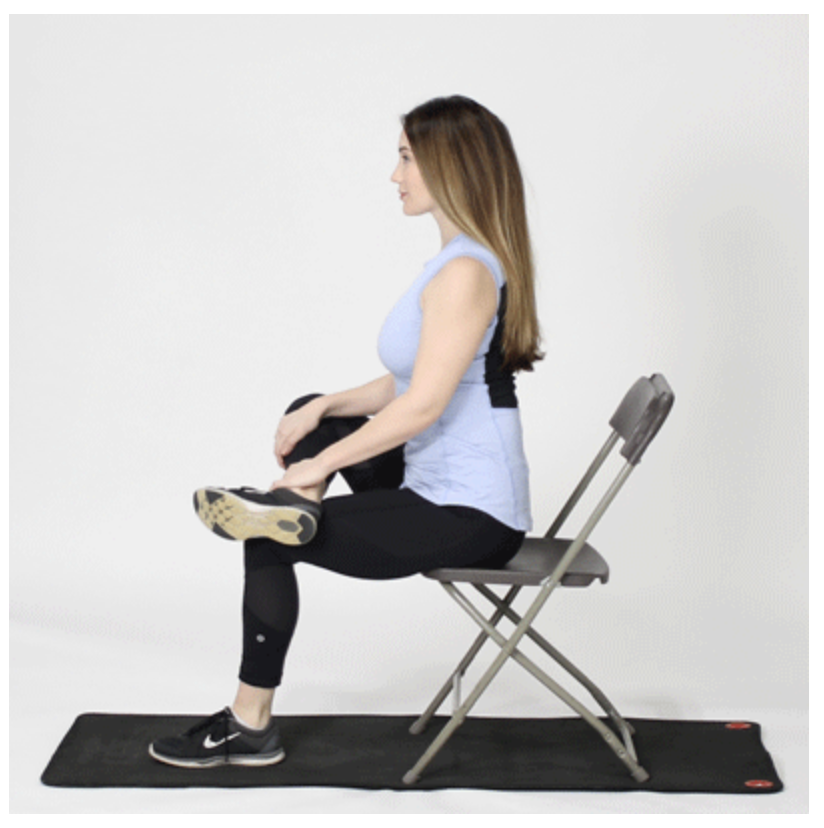
2. Spinal Freedom: For this one, sit down with your legs straight out in front. Bend your right knee and place your foot on the outside of your left leg. Place your right hand on the floor behind you and twist your body gently to the right, bringing your left elbow across your right knee. Hold the stretch for 20 to 30 seconds before switching to the other side. This stretch helps create space in your spine and eases pressure on the sciatic nerve.
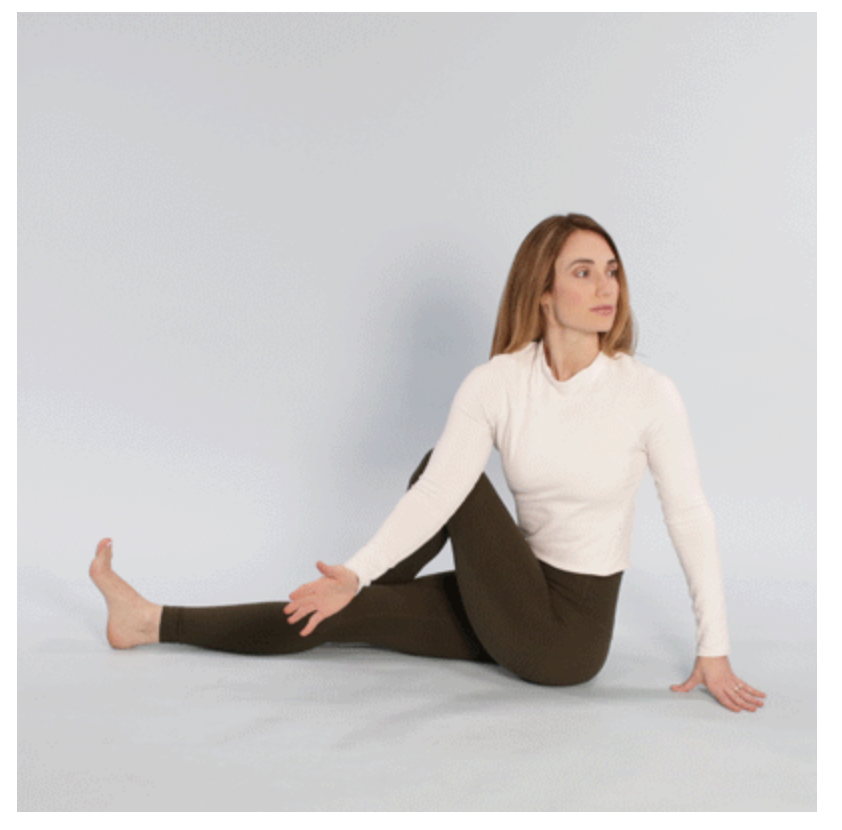
3. Chair of Strength: Sit on a chair and cross one leg over the other so your ankle rests on your opposite knee. Slowly lean forward until you feel a stretch through your hips and glutes. Stay in this position for 20 to 30 seconds, then repeat with the other leg. This stretch not only relieves tightness but also builds strength and flexibility over time.
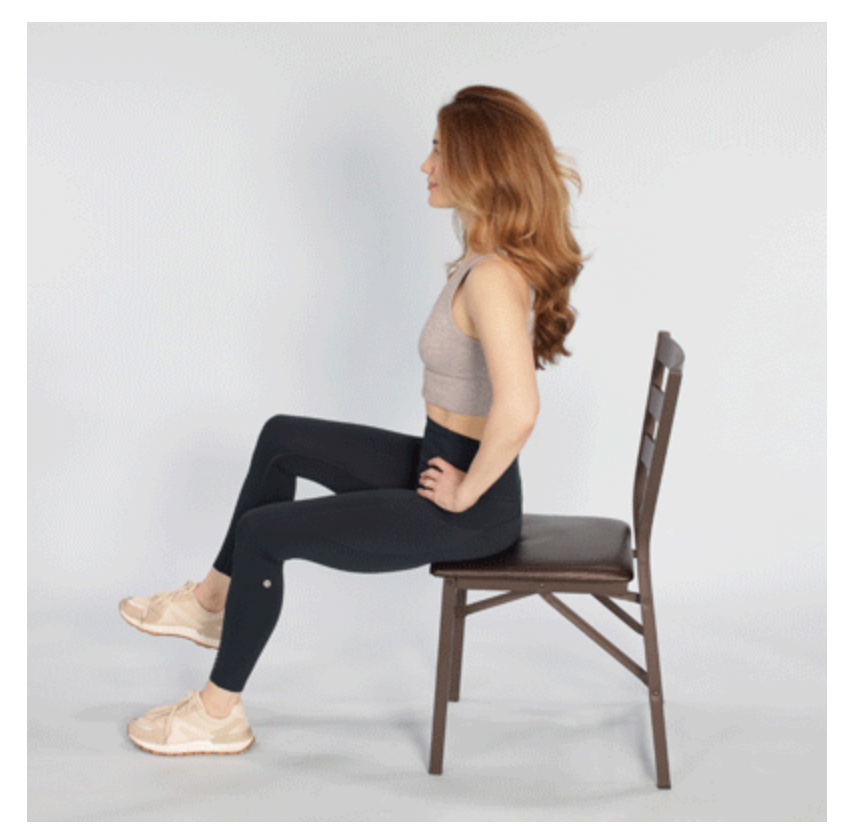
4. “Figure of Balance”: This stretch, often called the figure 4, is excellent for opening up your hips and easing tightness. Lie flat on your back and cross one ankle over the opposite knee, forming the shape of a “4.” Take a few deep breaths and let gravity help you sink deeper into the stretch. Relax into it and allow your hips to loosen up as you hold the position.
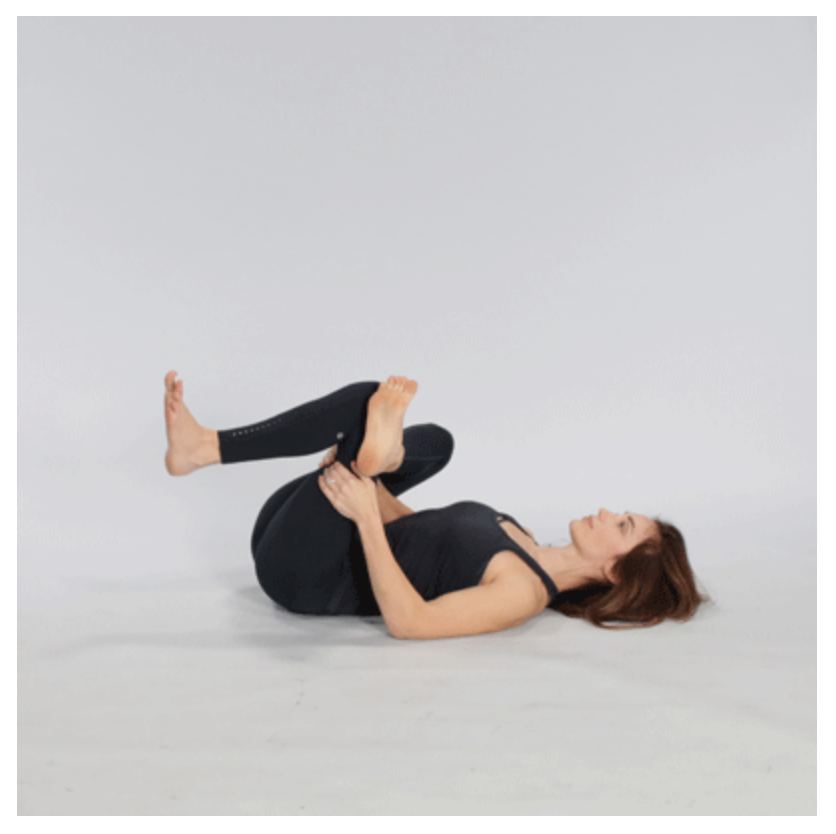
The figure-4 stretch is effective in targeting and stretching the piriformis muscle.
5. “Knee to Heart”: This move is known as the knee-to-opposite-shoulder stretch. Lie on your back, bend one knee, and gently pull it across your body toward the opposite shoulder. Please don’t force it; ensure you do what you are comfortable with. Do this for 20 to 30 seconds, then switch to the other side. This stretch helps release tight muscles in the lower back and can ease sciatic nerve pain.
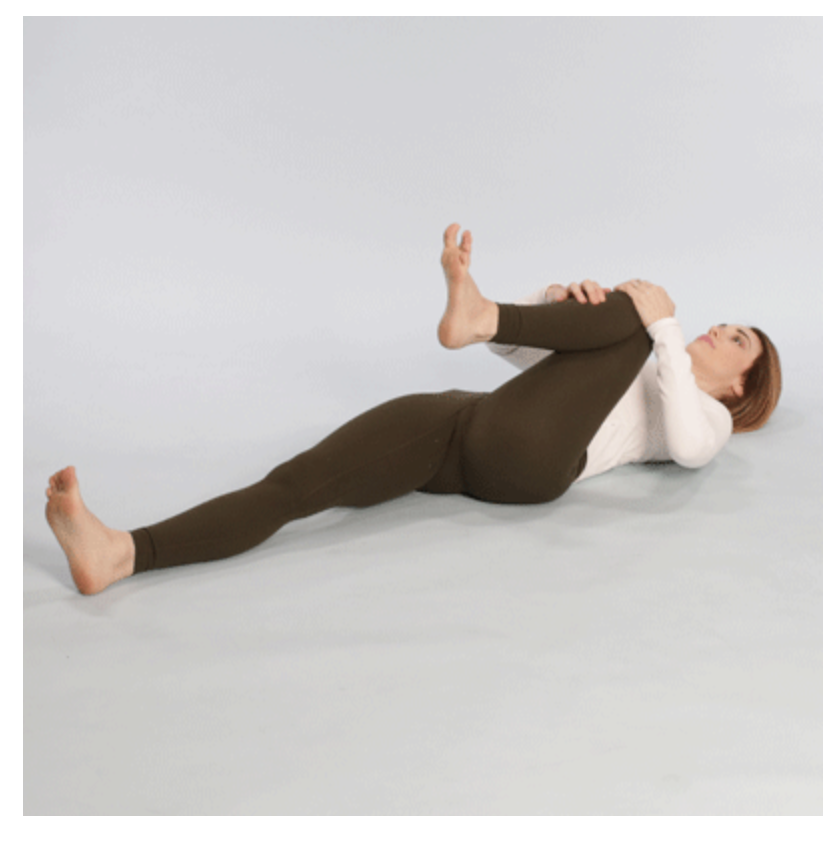
6. “Hamstring Soar”: Tight hamstrings can make sciatica worse, so this standing hamstring stretch is beneficial. Stand with your feet hip-width apart, bend forward slowly, and reach for your toes (or as far as you can). Keep your knees slightly bent if needed. You should feel the stretch along the back of your legs. Hold the position and take deep breaths to help your muscles relax.
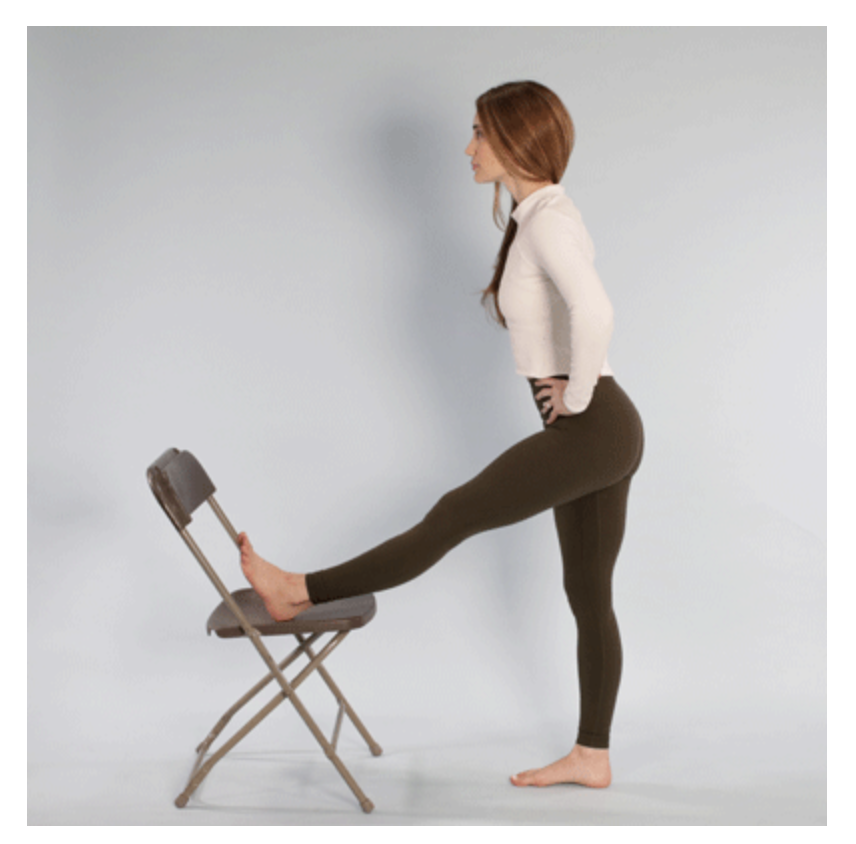
7. “Piriformis Balance”: Standing piriformis stretch is a move that can help with sciatica. All you have to do is stand up straight, hold your balance, and ease into the stretch until you feel it working in your hips. Take slow breaths while you have it. This stretch will allow your muscles to release some of that tightness so you can feel a bit lighter.
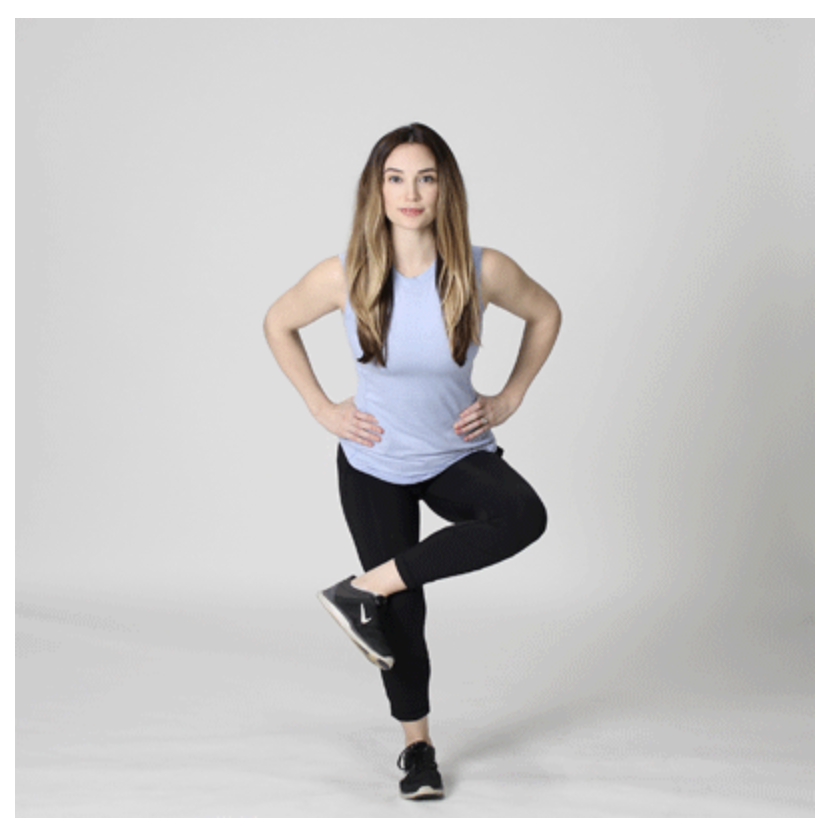
8. “Hamstring Harmony”: Tight hamstrings can make sciatica worse, but if you are looking for a safe and easy stretch, the scissor hamstring stretch is your best option. When you do it, you’ll feel the pull in your thighs and hips. It might be painful at first, but with time, you’ll notice that the muscles will start to loosen and take pressure off the nerve.
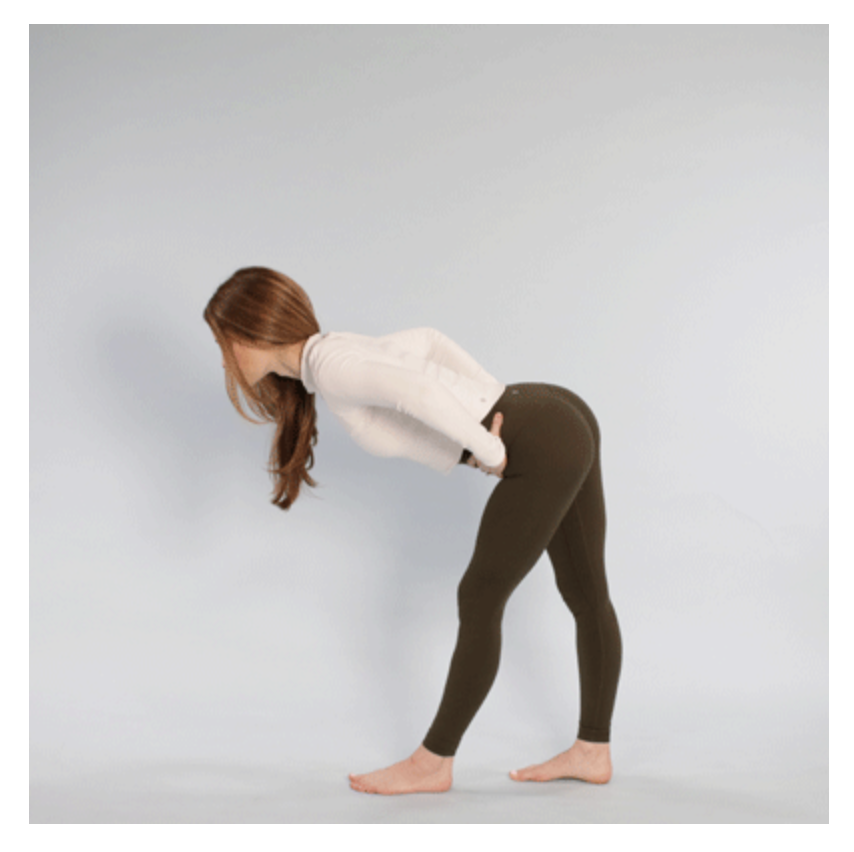
9. “Pigeon Positivity”: The pigeon pose is another stretch you can add to your routine. Start by moving into the position slowly, then lean forward gently until you feel a deep stretch in your hip. Use your arms for support to avoid straining. This move is ideal for opening up tight hips and providing relief from pain.
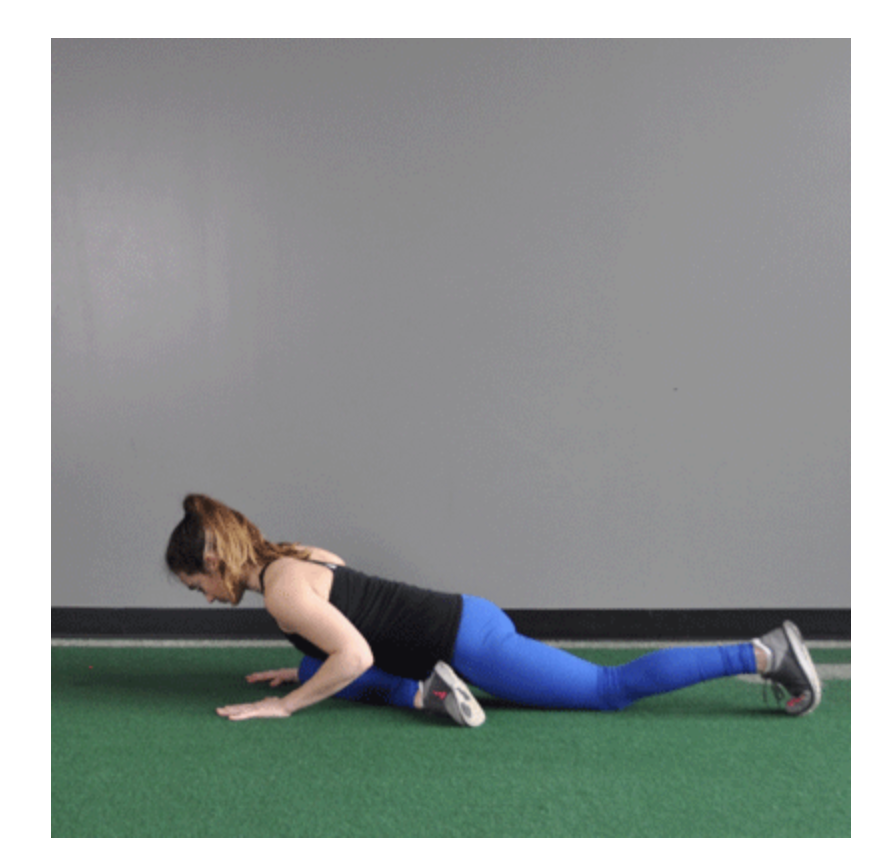
Frequently asked questions
Can stretching help alleviate sciatica?
Yes, stretching can play a significant role in easing sciatica. When you work with a trained healthcare professional, you can learn safe and effective movements that can aid in your recovery. These movements can help alleviate pain, enhance flexibility, and promote healing. In fact, around 80% to 90% of people notice real progress as they stick with the recovery process. Be patient with your body, trust the exercises, and believe in your ability to heal.
What are some empowering exercises to alleviate sciatica pain?
Simple stretches, such as seated glute stretches, sitting spinal twists, and basic seated forward bends, can help strengthen your back and hips while easing pain. Standing stretches, such as the scissor hamstring stretch, are also great for relieving tightness and improving flexibility. Adding these to your routine can help reduce discomfort and make everyday movement easier.
What are the most effective stretches for relieving sciatica?
Some of the best stretches for easing sciatica pain can be done sitting, standing, or lying down. Popular ones include the seated figure 4 stretch, basic seated stretches, the pigeon pose, and the standing piriformis stretch. Since everyone’s body is different, the most effective approach is to work with a healthcare professional who can design a routine tailored to your specific needs and limitations.
What stretch can be done for sciatica relief in just 30 seconds?
There isn’t a magic “30-second” stretch that works for everyone, but many stretches can help if you hold them for about half a minute. A few good options are the seated glute stretch, the sitting spinal twist, and the knee-to-opposite-shoulder stretch. The key is to listen to your body, avoid pushing into pain, and focus on being consistent. Over time, these short stretches can make a big difference.
Conclusion
Adding various stretches and massage techniques to your routine can make a significant difference in managing sciatica. Massage, intense tissue work, is one of the most effective ways to release tight spots and calm discomfort in the sciatic nerve.
So, does massage actually help sciatica? The answer is yes. Massage therapy not only eases nerve pain but also allows the surrounding muscles to relax, supporting better healing and reducing stress on your back.
At Massaggi London, our experienced therapists know how to employ the proper massage techniques to alleviate sciatica symptoms. Each session is personalised to match what your body needs. Our therapists work on the areas where the sciatic nerve causes pain to ease muscle tension, calm inflammation, and support your body’s natural healing process. If you’re seeking the most effective massage for sciatica or want to incorporate massage therapy into your overall pain relief plan, consider these options. In that case, our team is here to help you feel better and move toward recovery.
